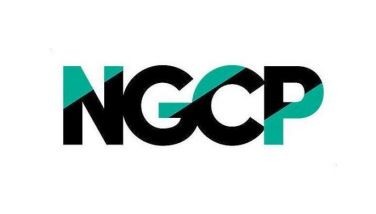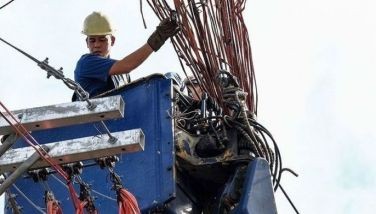AustralAsian shows interest in Malampaya oil prospects
September 10, 2005 | 12:00am
AustralAsian Energy Ltd. is set to join other foreign groups keen on developing the Malampaya oil rim in northwest Palawan.
AustralAsian chairman Rufino Bomasang said the company has been offered by the state-run Philippine National Oil Co.-Exploration Corp. (PNOC-EC) to participate in the development of the oil rim, which is believed to have recoverable oil deposits of 40 million barrels.
PNOC-EC is a member of the consortium holding Service Contract (SC) 38, allowing them to explore oil and gas reserves in Malampaya.
PNOC-EC’s stake in the project is 10 percent while Shell Phils. Exploration B.V. (Spex) and Chevron-Texaco hold 45 percent each.
"We are open to partnering with the Malampaya consortium or signing a deal with them as an independent contractor," said Bomasang.
Spex was previously looking at the option of asking other companies to participate in the Malampaya oil development. It also has the option to enter into joint ventures or farm in agreements with several companies to extract the Malampaya oil.
AustralAsian Energy is a wholly-owned subsidiary of Middle East Petroleum Services (MEP) tasked to look into exploration and production in the AustralAsian region with its main focus in the Philippines.
MEP, on the other hand, is part of the Azerbaijani holding company Azersun Holding, and specializes in transporting oil from Kazakhstan and Turkmenistan.
The company leads the consortium holding SC 50, which covers 172,000 hectares in Northwest Palawan basin. It hosts the South Calauit oilfields which contain existing proven oil reserves.
The other members of AustralAsian consortium includes Australia’s Ottoman Energy Ltd., and RGA Resources Inc. The consortium is expected to invest $10.2 million during the seven-year exploration period.
Aside from AustralAsian, the development of the oil rim has drawn strong interest from US-based Argo Group, PetroEnergy Resources Corp. (PERC) and South China Resources Inc.
Norwegian firm Norsk Hydro ASA also expressed interest but backed out, citing it has other priorities. Instead, it is pushing another Norwegian firm Petroleum Geoservices to develop it.
PNOC-EC has also expressed willingness to develop the Malampaya oil rim if asked by government to do so.
The government has been pressuring the Malampaya consortium to develop the oil rim in the wake of the unprecedented surge of oil prices in the world market.
The Malampaya oil rim is a 56-meter thick oil zone that occurs right below the 600-meter thick gas cap of the Malampaya deep water gas-to-power project.
Estimated to generate at least $2 billion in revenues, it was initially discovered with the drilling of well Malampaya-1 in 1991 but was considered at the onset as a separate development from the much larger natural gas reserves comprising the bulk of the Malampaya petroleum resources.
Another group which wants to undertake its development is the Houston-based Argo Group LLC which said it could start work as early as May 2006.
"The Argo Group is confident that a safe, cost effective, and practical oil recovery solution is available. We believe we clearly defined the benefits of our proposed solution and trust the plan may be considered as part of a realistic solution. The proposed solution not only exploits the proven oil reserves cost effectively, but also allows for protection of the existing gas reservoir," said Bobby Quintos, president and senior partner of the Argo Group.
The Argo Group said its plan guarantees safe extraction of resources which will be a multi-stage approach that will entail minimal intrusion of the existing gas reservoir operations.
Argo said it could extract oil from Malampaya by May 2006 and beyond that would be difficult.
"We have assumed that there may be no more than a three-year window available to extract the oil which includes the order of long-lead items. After this period, reservoir pressure will have been depleted from the existing gas production to an extent that is likely to prevent further commercial production of the oil," said Quintos.
AustralAsian chairman Rufino Bomasang said the company has been offered by the state-run Philippine National Oil Co.-Exploration Corp. (PNOC-EC) to participate in the development of the oil rim, which is believed to have recoverable oil deposits of 40 million barrels.
PNOC-EC is a member of the consortium holding Service Contract (SC) 38, allowing them to explore oil and gas reserves in Malampaya.
PNOC-EC’s stake in the project is 10 percent while Shell Phils. Exploration B.V. (Spex) and Chevron-Texaco hold 45 percent each.
"We are open to partnering with the Malampaya consortium or signing a deal with them as an independent contractor," said Bomasang.
Spex was previously looking at the option of asking other companies to participate in the Malampaya oil development. It also has the option to enter into joint ventures or farm in agreements with several companies to extract the Malampaya oil.
AustralAsian Energy is a wholly-owned subsidiary of Middle East Petroleum Services (MEP) tasked to look into exploration and production in the AustralAsian region with its main focus in the Philippines.
MEP, on the other hand, is part of the Azerbaijani holding company Azersun Holding, and specializes in transporting oil from Kazakhstan and Turkmenistan.
The company leads the consortium holding SC 50, which covers 172,000 hectares in Northwest Palawan basin. It hosts the South Calauit oilfields which contain existing proven oil reserves.
The other members of AustralAsian consortium includes Australia’s Ottoman Energy Ltd., and RGA Resources Inc. The consortium is expected to invest $10.2 million during the seven-year exploration period.
Aside from AustralAsian, the development of the oil rim has drawn strong interest from US-based Argo Group, PetroEnergy Resources Corp. (PERC) and South China Resources Inc.
Norwegian firm Norsk Hydro ASA also expressed interest but backed out, citing it has other priorities. Instead, it is pushing another Norwegian firm Petroleum Geoservices to develop it.
PNOC-EC has also expressed willingness to develop the Malampaya oil rim if asked by government to do so.
The government has been pressuring the Malampaya consortium to develop the oil rim in the wake of the unprecedented surge of oil prices in the world market.
The Malampaya oil rim is a 56-meter thick oil zone that occurs right below the 600-meter thick gas cap of the Malampaya deep water gas-to-power project.
Estimated to generate at least $2 billion in revenues, it was initially discovered with the drilling of well Malampaya-1 in 1991 but was considered at the onset as a separate development from the much larger natural gas reserves comprising the bulk of the Malampaya petroleum resources.
Another group which wants to undertake its development is the Houston-based Argo Group LLC which said it could start work as early as May 2006.
"The Argo Group is confident that a safe, cost effective, and practical oil recovery solution is available. We believe we clearly defined the benefits of our proposed solution and trust the plan may be considered as part of a realistic solution. The proposed solution not only exploits the proven oil reserves cost effectively, but also allows for protection of the existing gas reservoir," said Bobby Quintos, president and senior partner of the Argo Group.
The Argo Group said its plan guarantees safe extraction of resources which will be a multi-stage approach that will entail minimal intrusion of the existing gas reservoir operations.
Argo said it could extract oil from Malampaya by May 2006 and beyond that would be difficult.
"We have assumed that there may be no more than a three-year window available to extract the oil which includes the order of long-lead items. After this period, reservoir pressure will have been depleted from the existing gas production to an extent that is likely to prevent further commercial production of the oil," said Quintos.
BrandSpace Articles
<
>
- Latest
- Trending
Trending
Latest
Trending
Latest
Recommended




























